Inventory Disclosure Report: Woolworths Group Limited Analysis
VerifiedAdded on 2023/06/04
|6
|1194
|98
Report
AI Summary
This report provides an in-depth analysis of inventory disclosure requirements, using Woolworths Group Limited as a case study. It begins by outlining the importance of accurate disclosures in financial statements, particularly concerning inventory, due to the inherent risks involved. The report then examines Woolworths' inventory system, identifying it as periodic, and details the weighted average cost method used for cost assumptions. The impact of this cost assumption method on the profit and loss account is discussed, including specific figures from the 2018 financial year. Furthermore, the report highlights the factors that managerial accountants must consider when setting up accounting policies for inventory, such as product manufacturing cycles, perishability, market demand, and storage risks. The report concludes by emphasizing the importance of complete inventory disclosures, including the type of inventory accounting, cost assumptions, and their impact on financial statements. This report is available on Desklib, a platform offering study tools for students, including past papers and solved assignments.
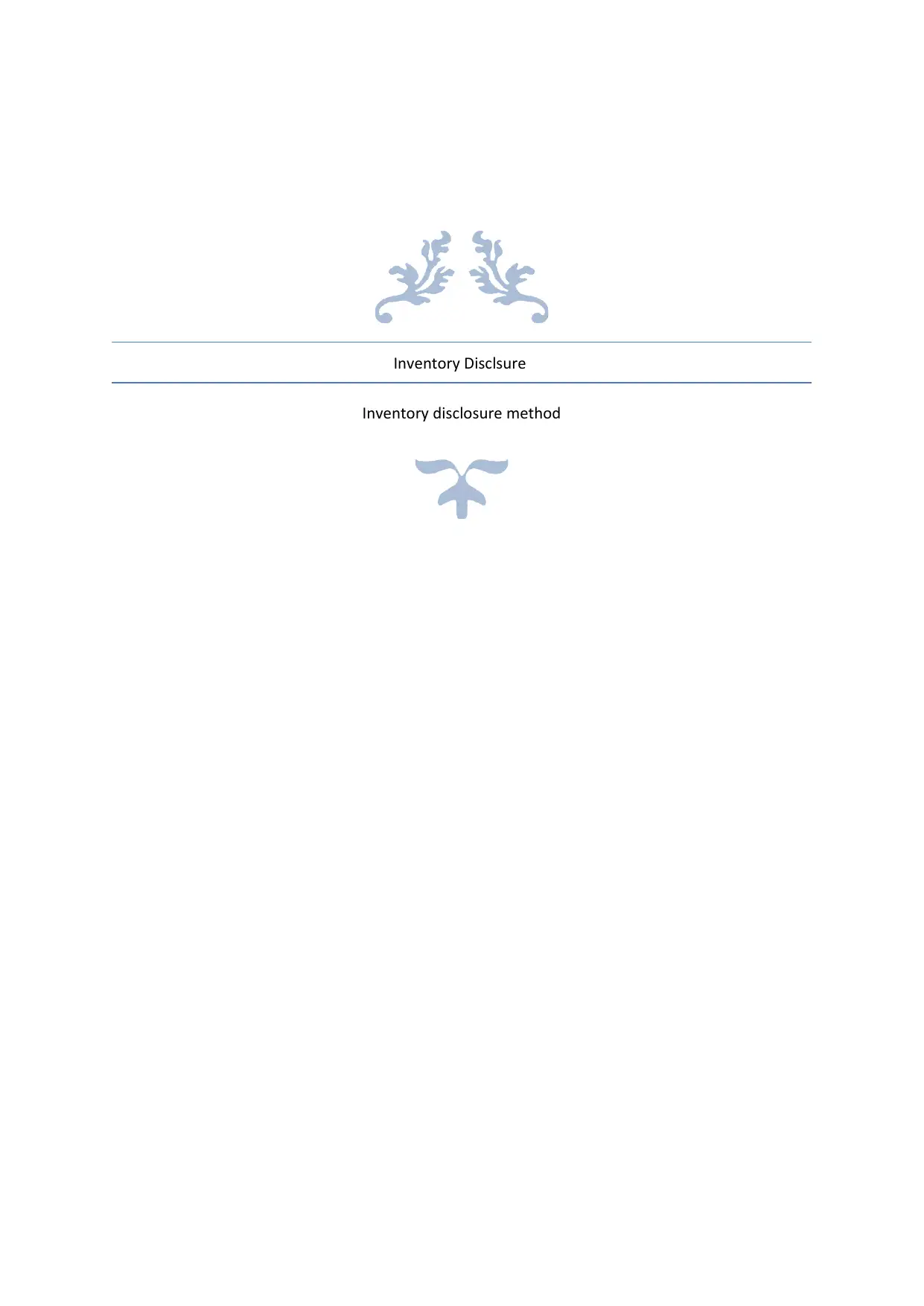
Inventory Disclsure
Inventory disclosure method
Inventory disclosure method
Paraphrase This Document
Need a fresh take? Get an instant paraphrase of this document with our AI Paraphraser
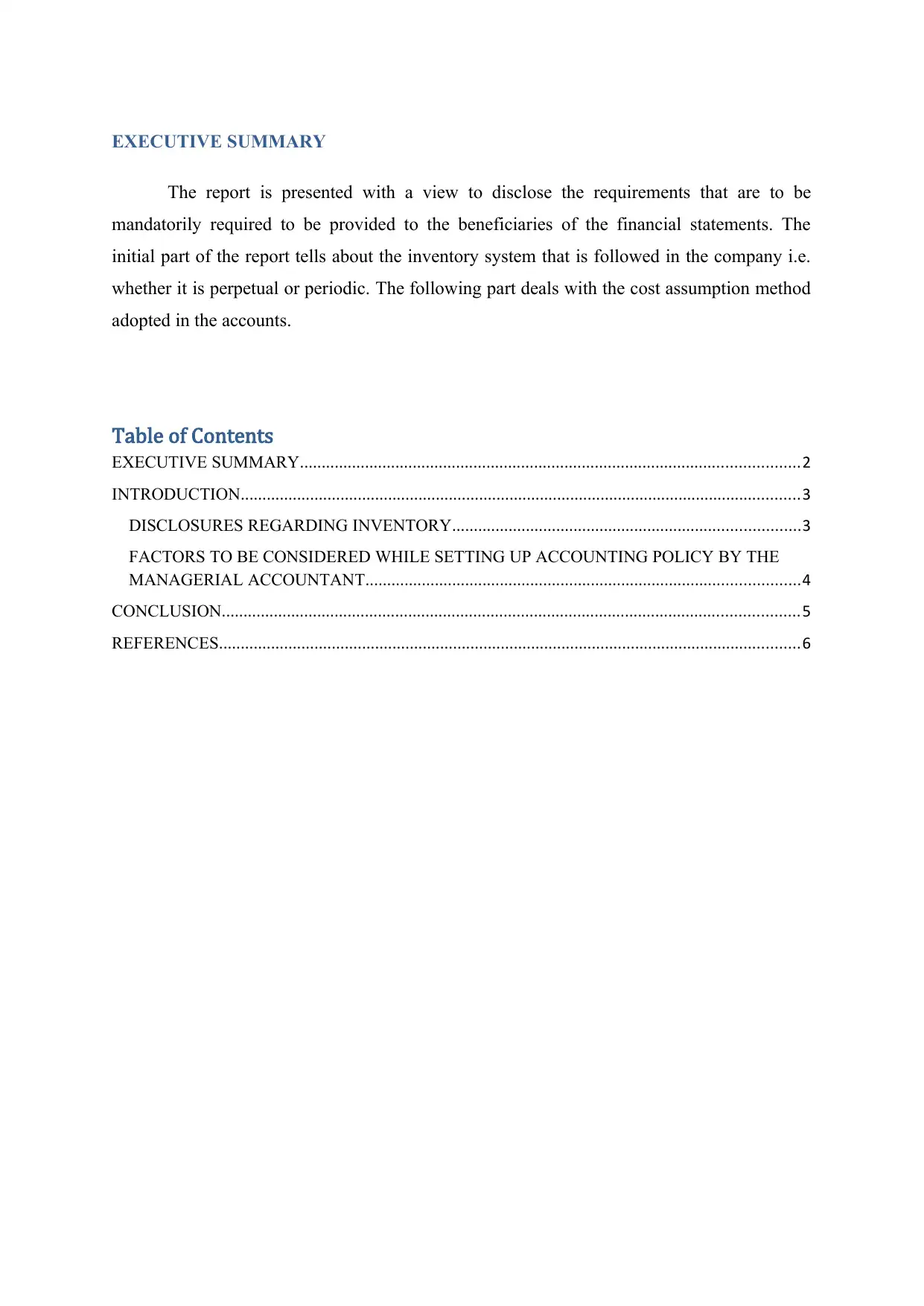
EXECUTIVE SUMMARY
The report is presented with a view to disclose the requirements that are to be
mandatorily required to be provided to the beneficiaries of the financial statements. The
initial part of the report tells about the inventory system that is followed in the company i.e.
whether it is perpetual or periodic. The following part deals with the cost assumption method
adopted in the accounts.
Table of Contents
EXECUTIVE SUMMARY...................................................................................................................2
INTRODUCTION.................................................................................................................................3
DISCLOSURES REGARDING INVENTORY................................................................................3
FACTORS TO BE CONSIDERED WHILE SETTING UP ACCOUNTING POLICY BY THE
MANAGERIAL ACCOUNTANT....................................................................................................4
CONCLUSION.....................................................................................................................................5
REFERENCES......................................................................................................................................6
The report is presented with a view to disclose the requirements that are to be
mandatorily required to be provided to the beneficiaries of the financial statements. The
initial part of the report tells about the inventory system that is followed in the company i.e.
whether it is perpetual or periodic. The following part deals with the cost assumption method
adopted in the accounts.
Table of Contents
EXECUTIVE SUMMARY...................................................................................................................2
INTRODUCTION.................................................................................................................................3
DISCLOSURES REGARDING INVENTORY................................................................................3
FACTORS TO BE CONSIDERED WHILE SETTING UP ACCOUNTING POLICY BY THE
MANAGERIAL ACCOUNTANT....................................................................................................4
CONCLUSION.....................................................................................................................................5
REFERENCES......................................................................................................................................6
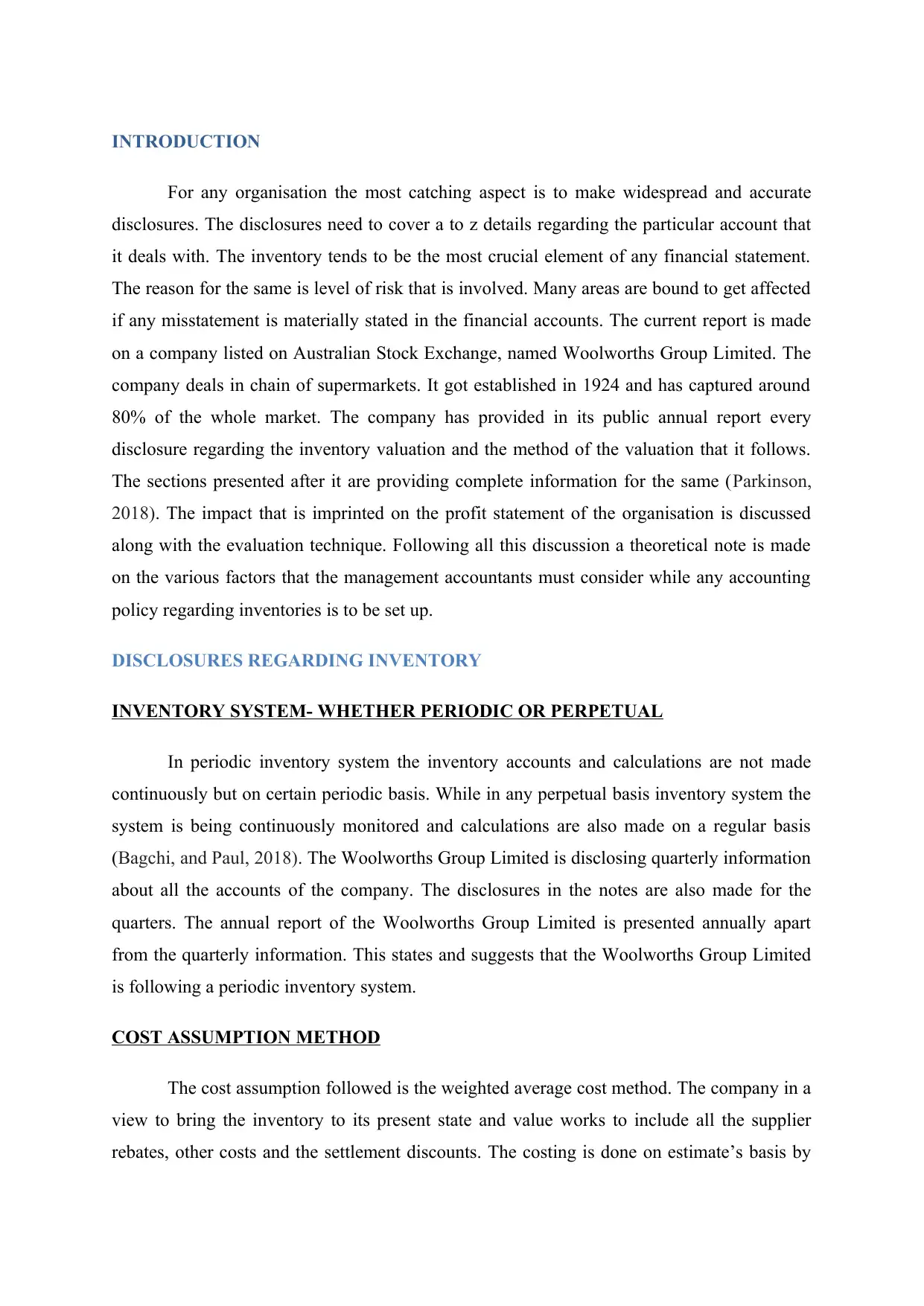
INTRODUCTION
For any organisation the most catching aspect is to make widespread and accurate
disclosures. The disclosures need to cover a to z details regarding the particular account that
it deals with. The inventory tends to be the most crucial element of any financial statement.
The reason for the same is level of risk that is involved. Many areas are bound to get affected
if any misstatement is materially stated in the financial accounts. The current report is made
on a company listed on Australian Stock Exchange, named Woolworths Group Limited. The
company deals in chain of supermarkets. It got established in 1924 and has captured around
80% of the whole market. The company has provided in its public annual report every
disclosure regarding the inventory valuation and the method of the valuation that it follows.
The sections presented after it are providing complete information for the same (Parkinson,
2018). The impact that is imprinted on the profit statement of the organisation is discussed
along with the evaluation technique. Following all this discussion a theoretical note is made
on the various factors that the management accountants must consider while any accounting
policy regarding inventories is to be set up.
DISCLOSURES REGARDING INVENTORY
INVENTORY SYSTEM- WHETHER PERIODIC OR PERPETUAL
In periodic inventory system the inventory accounts and calculations are not made
continuously but on certain periodic basis. While in any perpetual basis inventory system the
system is being continuously monitored and calculations are also made on a regular basis
(Bagchi, and Paul, 2018). The Woolworths Group Limited is disclosing quarterly information
about all the accounts of the company. The disclosures in the notes are also made for the
quarters. The annual report of the Woolworths Group Limited is presented annually apart
from the quarterly information. This states and suggests that the Woolworths Group Limited
is following a periodic inventory system.
COST ASSUMPTION METHOD
The cost assumption followed is the weighted average cost method. The company in a
view to bring the inventory to its present state and value works to include all the supplier
rebates, other costs and the settlement discounts. The costing is done on estimate’s basis by
For any organisation the most catching aspect is to make widespread and accurate
disclosures. The disclosures need to cover a to z details regarding the particular account that
it deals with. The inventory tends to be the most crucial element of any financial statement.
The reason for the same is level of risk that is involved. Many areas are bound to get affected
if any misstatement is materially stated in the financial accounts. The current report is made
on a company listed on Australian Stock Exchange, named Woolworths Group Limited. The
company deals in chain of supermarkets. It got established in 1924 and has captured around
80% of the whole market. The company has provided in its public annual report every
disclosure regarding the inventory valuation and the method of the valuation that it follows.
The sections presented after it are providing complete information for the same (Parkinson,
2018). The impact that is imprinted on the profit statement of the organisation is discussed
along with the evaluation technique. Following all this discussion a theoretical note is made
on the various factors that the management accountants must consider while any accounting
policy regarding inventories is to be set up.
DISCLOSURES REGARDING INVENTORY
INVENTORY SYSTEM- WHETHER PERIODIC OR PERPETUAL
In periodic inventory system the inventory accounts and calculations are not made
continuously but on certain periodic basis. While in any perpetual basis inventory system the
system is being continuously monitored and calculations are also made on a regular basis
(Bagchi, and Paul, 2018). The Woolworths Group Limited is disclosing quarterly information
about all the accounts of the company. The disclosures in the notes are also made for the
quarters. The annual report of the Woolworths Group Limited is presented annually apart
from the quarterly information. This states and suggests that the Woolworths Group Limited
is following a periodic inventory system.
COST ASSUMPTION METHOD
The cost assumption followed is the weighted average cost method. The company in a
view to bring the inventory to its present state and value works to include all the supplier
rebates, other costs and the settlement discounts. The costing is done on estimate’s basis by
⊘ This is a preview!⊘
Do you want full access?
Subscribe today to unlock all pages.

Trusted by 1+ million students worldwide
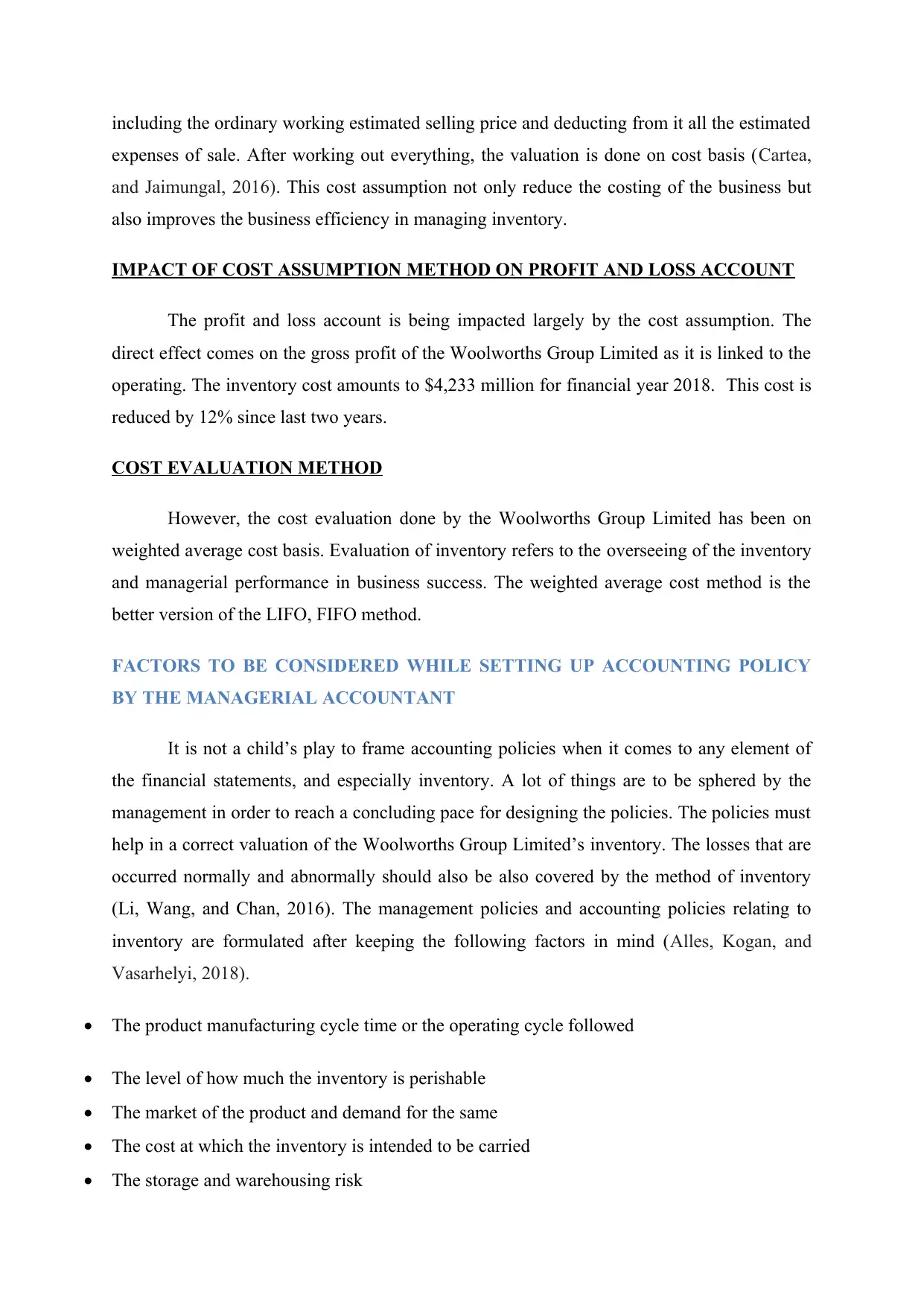
including the ordinary working estimated selling price and deducting from it all the estimated
expenses of sale. After working out everything, the valuation is done on cost basis (Cartea,
and Jaimungal, 2016). This cost assumption not only reduce the costing of the business but
also improves the business efficiency in managing inventory.
IMPACT OF COST ASSUMPTION METHOD ON PROFIT AND LOSS ACCOUNT
The profit and loss account is being impacted largely by the cost assumption. The
direct effect comes on the gross profit of the Woolworths Group Limited as it is linked to the
operating. The inventory cost amounts to $4,233 million for financial year 2018. This cost is
reduced by 12% since last two years.
COST EVALUATION METHOD
However, the cost evaluation done by the Woolworths Group Limited has been on
weighted average cost basis. Evaluation of inventory refers to the overseeing of the inventory
and managerial performance in business success. The weighted average cost method is the
better version of the LIFO, FIFO method.
FACTORS TO BE CONSIDERED WHILE SETTING UP ACCOUNTING POLICY
BY THE MANAGERIAL ACCOUNTANT
It is not a child’s play to frame accounting policies when it comes to any element of
the financial statements, and especially inventory. A lot of things are to be sphered by the
management in order to reach a concluding pace for designing the policies. The policies must
help in a correct valuation of the Woolworths Group Limited’s inventory. The losses that are
occurred normally and abnormally should also be also covered by the method of inventory
(Li, Wang, and Chan, 2016). The management policies and accounting policies relating to
inventory are formulated after keeping the following factors in mind (Alles, Kogan, and
Vasarhelyi, 2018).
The product manufacturing cycle time or the operating cycle followed
The level of how much the inventory is perishable
The market of the product and demand for the same
The cost at which the inventory is intended to be carried
The storage and warehousing risk
expenses of sale. After working out everything, the valuation is done on cost basis (Cartea,
and Jaimungal, 2016). This cost assumption not only reduce the costing of the business but
also improves the business efficiency in managing inventory.
IMPACT OF COST ASSUMPTION METHOD ON PROFIT AND LOSS ACCOUNT
The profit and loss account is being impacted largely by the cost assumption. The
direct effect comes on the gross profit of the Woolworths Group Limited as it is linked to the
operating. The inventory cost amounts to $4,233 million for financial year 2018. This cost is
reduced by 12% since last two years.
COST EVALUATION METHOD
However, the cost evaluation done by the Woolworths Group Limited has been on
weighted average cost basis. Evaluation of inventory refers to the overseeing of the inventory
and managerial performance in business success. The weighted average cost method is the
better version of the LIFO, FIFO method.
FACTORS TO BE CONSIDERED WHILE SETTING UP ACCOUNTING POLICY
BY THE MANAGERIAL ACCOUNTANT
It is not a child’s play to frame accounting policies when it comes to any element of
the financial statements, and especially inventory. A lot of things are to be sphered by the
management in order to reach a concluding pace for designing the policies. The policies must
help in a correct valuation of the Woolworths Group Limited’s inventory. The losses that are
occurred normally and abnormally should also be also covered by the method of inventory
(Li, Wang, and Chan, 2016). The management policies and accounting policies relating to
inventory are formulated after keeping the following factors in mind (Alles, Kogan, and
Vasarhelyi, 2018).
The product manufacturing cycle time or the operating cycle followed
The level of how much the inventory is perishable
The market of the product and demand for the same
The cost at which the inventory is intended to be carried
The storage and warehousing risk
Paraphrase This Document
Need a fresh take? Get an instant paraphrase of this document with our AI Paraphraser
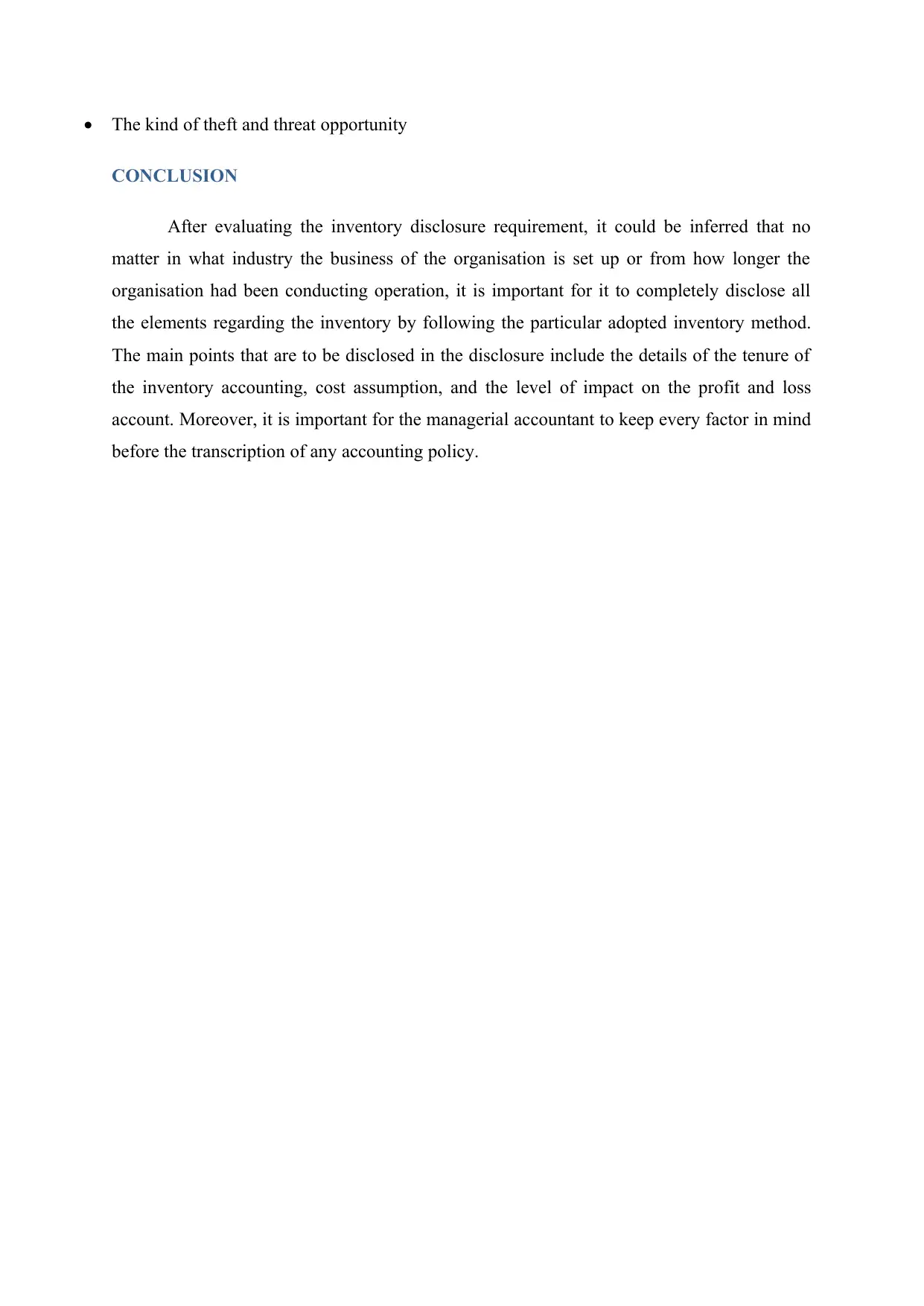
The kind of theft and threat opportunity
CONCLUSION
After evaluating the inventory disclosure requirement, it could be inferred that no
matter in what industry the business of the organisation is set up or from how longer the
organisation had been conducting operation, it is important for it to completely disclose all
the elements regarding the inventory by following the particular adopted inventory method.
The main points that are to be disclosed in the disclosure include the details of the tenure of
the inventory accounting, cost assumption, and the level of impact on the profit and loss
account. Moreover, it is important for the managerial accountant to keep every factor in mind
before the transcription of any accounting policy.
CONCLUSION
After evaluating the inventory disclosure requirement, it could be inferred that no
matter in what industry the business of the organisation is set up or from how longer the
organisation had been conducting operation, it is important for it to completely disclose all
the elements regarding the inventory by following the particular adopted inventory method.
The main points that are to be disclosed in the disclosure include the details of the tenure of
the inventory accounting, cost assumption, and the level of impact on the profit and loss
account. Moreover, it is important for the managerial accountant to keep every factor in mind
before the transcription of any accounting policy.
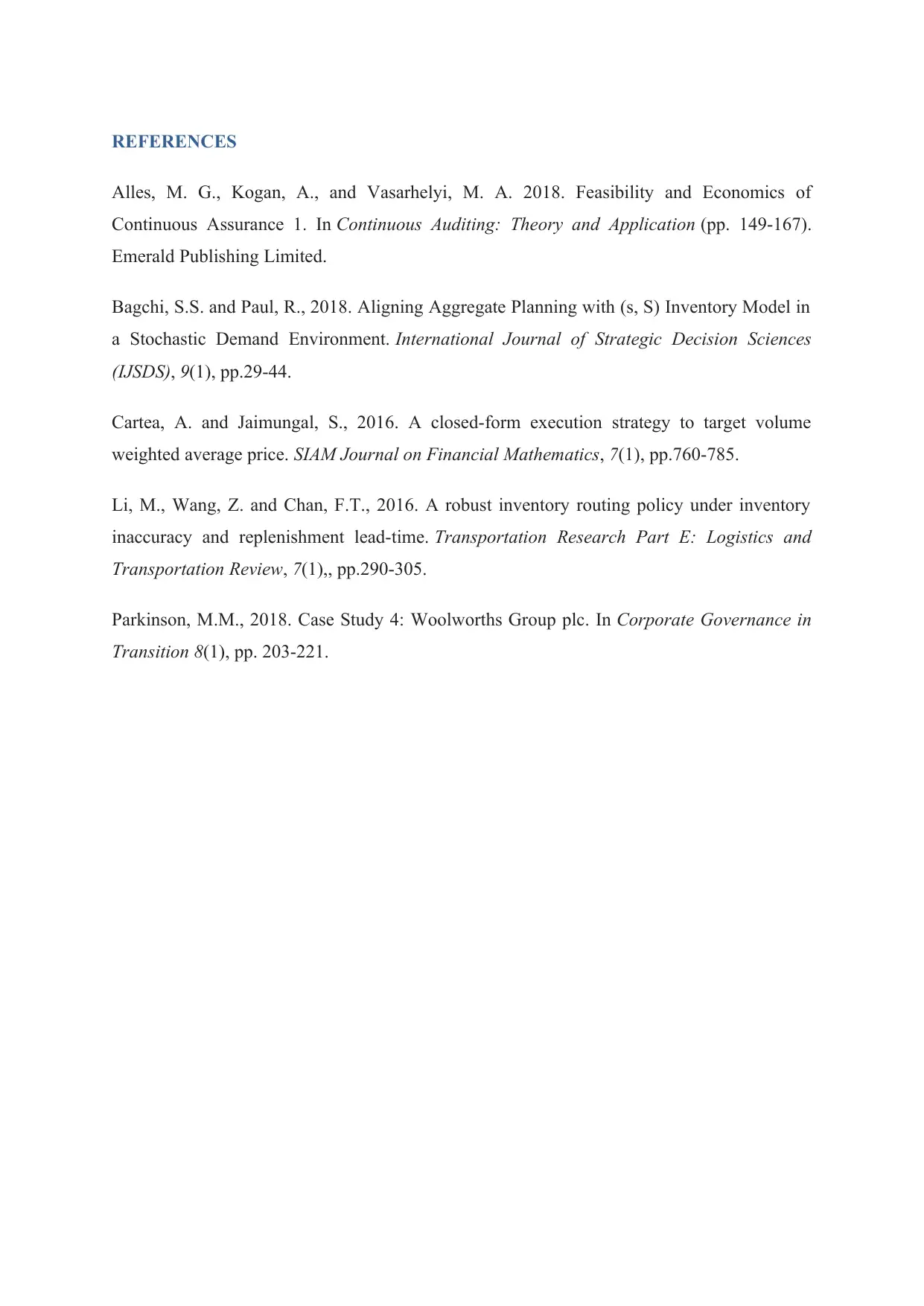
REFERENCES
Alles, M. G., Kogan, A., and Vasarhelyi, M. A. 2018. Feasibility and Economics of
Continuous Assurance 1. In Continuous Auditing: Theory and Application (pp. 149-167).
Emerald Publishing Limited.
Bagchi, S.S. and Paul, R., 2018. Aligning Aggregate Planning with (s, S) Inventory Model in
a Stochastic Demand Environment. International Journal of Strategic Decision Sciences
(IJSDS), 9(1), pp.29-44.
Cartea, A. and Jaimungal, S., 2016. A closed-form execution strategy to target volume
weighted average price. SIAM Journal on Financial Mathematics, 7(1), pp.760-785.
Li, M., Wang, Z. and Chan, F.T., 2016. A robust inventory routing policy under inventory
inaccuracy and replenishment lead-time. Transportation Research Part E: Logistics and
Transportation Review, 7(1),, pp.290-305.
Parkinson, M.M., 2018. Case Study 4: Woolworths Group plc. In Corporate Governance in
Transition 8(1), pp. 203-221.
Alles, M. G., Kogan, A., and Vasarhelyi, M. A. 2018. Feasibility and Economics of
Continuous Assurance 1. In Continuous Auditing: Theory and Application (pp. 149-167).
Emerald Publishing Limited.
Bagchi, S.S. and Paul, R., 2018. Aligning Aggregate Planning with (s, S) Inventory Model in
a Stochastic Demand Environment. International Journal of Strategic Decision Sciences
(IJSDS), 9(1), pp.29-44.
Cartea, A. and Jaimungal, S., 2016. A closed-form execution strategy to target volume
weighted average price. SIAM Journal on Financial Mathematics, 7(1), pp.760-785.
Li, M., Wang, Z. and Chan, F.T., 2016. A robust inventory routing policy under inventory
inaccuracy and replenishment lead-time. Transportation Research Part E: Logistics and
Transportation Review, 7(1),, pp.290-305.
Parkinson, M.M., 2018. Case Study 4: Woolworths Group plc. In Corporate Governance in
Transition 8(1), pp. 203-221.
⊘ This is a preview!⊘
Do you want full access?
Subscribe today to unlock all pages.

Trusted by 1+ million students worldwide
1 out of 6
Related Documents
Your All-in-One AI-Powered Toolkit for Academic Success.
+13062052269
info@desklib.com
Available 24*7 on WhatsApp / Email
![[object Object]](/_next/static/media/star-bottom.7253800d.svg)
Unlock your academic potential
Copyright © 2020–2025 A2Z Services. All Rights Reserved. Developed and managed by ZUCOL.





